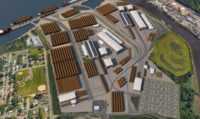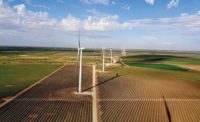UK Plans Bigger Projects As World's Largest Offshore Wind Farm Finishes

World’s largest offshore wind energy project, in North Sea, is set to produce 1 GW in 2020.
PHOTO COURTESY ORSTED
The final turbine for the world’s largest offshore wind energy farm, located off the British coast, was installed earlier this month. Hornsea I is the first set to generate more than 1 GW—the size and scale needed to drive down power prices to compete with fossil generation.
The U.K. now is gearing up for an even larger project.
The estimated $11-billion, 1.2-GW Hornsea I, located in the North Sea more than 60 miles off Yorkshire, England, includes a 174-turbine array over 407 sq miles that was completed in nine months and paves the way for the next generation of offshore wind farms, says Duncan Clark, program director for its Denmark-based developer Orsted A/S.
Construction of the farm, powered by 7-MW Siemens Gamesa turbines, began in early 2018. It will operate in 2020.
Meanwhile, three offshore wind projects, each capable of generating 1.2 GW of power, won the U.K.’s late-September auction for renewable energy with an average winning price less than the average of traditional wholesale fossil fuel power.
The average winning price was about $51 per MWh, far less than the winning $72.30 per MWh price in 2017. “The latest U.K. auction prices for fixed foundation offshore wind is an indication of industry and technological maturity,” says Alla Weinstein, founder and CEO of California-based offshore wind developer Trident Winds.
Norway-based developer Equinor and its Scottish utility partner SSE won the auction with three large scale offshore wind projects to be located in the Dogger Bank region of the North Sea, with a total capacity of 3.6 GW.
“The auction results reflect the continued cost reductions and technological developments and the increasing competitiveness of bottom-fixed offshore wind,” Equinor said. This represents a “game changer” for the company’s offshore wind business, said CEO Eldar Saetre in a statement.
Sector participants credit larger component size and a supportive government framework for the low prices, providing “confidence to investors and the benefits of scale and certainty to the supply chain,” said Matthew Wright, Orsted managing director.
U.K. offshore wind procurement uses a “contract for differences” approach in which the government guarantees a minimum price but gains a refund from the developer for the difference if the average wholesale price is lower.
“The declining U.K. offshore wind strike price will force developers to prepare for bids below current power prices or to follow a pure merchant route to market,” says Shimeng Yang, senor research analyst for market consultant Wood Mackenzie.
The U.K. also announced on Oct. 14 the next round of offshore wind leases, from which the government will gauge developer interest and financial and technical ability to add 7 GW to its 9 GW of operating offshore wind. Another 4 GW is currently being built.
The U.K. has a mandate to be carbon neutral by 2050.




